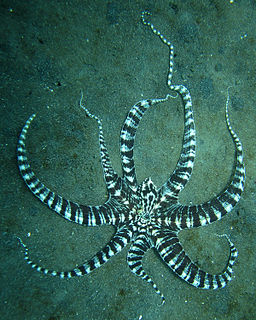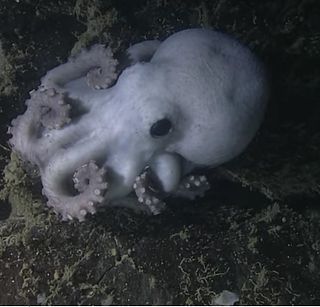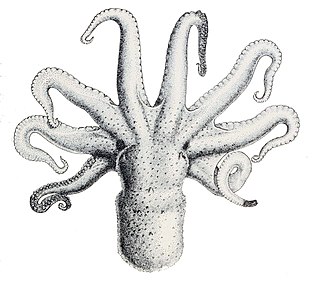
Octopus relates to approximately 300 species of soft-bodied, eight-limbed molluscs of the order Octopoda. The order is grouped within the class Cephalopoda with squids, cuttlefish, and nautiloids. Like other cephalopods, an octopus is bilaterally symmetric with two eyes and a beak, with its mouth at the center point of the eight limbs. The soft body can rapidly alter its shape, enabling octopuses to squeeze through small gaps. They trail their eight appendages behind them as they swim. The siphon is used both for respiration and for locomotion, by expelling a jet of water. Octopuses have a complex nervous system and excellent sight, and are among the most intelligent and behaviourally diverse of all invertebrates.

Grimpoteuthis is a genus of pelagic umbrella octopuses known as the dumbo octopuses. The name "dumbo" originates from their resemblance to the title character of Disney's 1941 film Dumbo, having a prominent ear-like fin which extends from the mantle above each eye. There are 15 species recognized in the genus. Prey include crustaceans, bivalves, worms and copepods. The average life span of various Grimpoteuthis species is 3 to 5 years.

Umbrella octopuses are a group of pelagic octopuses. Umbrella octopuses are characterized by a web of skin between the tentacles, causing them to somewhat resemble an opened umbrella when the tentacles are spread.

The Octopodidae comprise the family containing the majority of known octopus species.

The mimic octopus is an Indo-Pacific species of octopus from the Indo-Pacific region. Like other octopuses, it uses its chromatophores to disguise itself with its background. However, it is noteworthy for being able to impersonate a wide variety of other marine animals. Although many animals mimic either their environment or other animals to avoid predation, the mimic octopus and its close relative the wunderpus are the only ones known to actively imitate a number of animals in order to elude predators.

Octopus is the largest genus of octopuses, comprising more than 100 species. These species are widespread throughout the world's oceans. Many species formerly placed in the genus Octopus are now assigned to other genera within the family Octopodidae.

Eledone is a genus of octopuses forming the only genus in the family Eledonidae. It is mainly distributed in the northern and southern Atlantic Ocean, with one species, E. palari, described from the southwestern Pacific Ocean and eastern Indian Ocean in waters around Indonesia and Australia and another, E. microsicya, from the western Indian Ocean. One species, E. thysanophora, is now regarded as a synonym of the brush-tipped octopus.

Graneledone is a genus of octopuses in the family Octopodidae. The type species is Eledone verrucosaVerrill, 1881.

All cephalopods possess flexible limbs extending from their heads and surrounding their beaks. These appendages, which function as muscular hydrostats, have been variously termed arms, legs or tentacles.

Callistoctopus is a genus of nocturnal, orange octopuses in the family Octopodidae. They are readily identifiable by their reddish coloring, the white papillae that line their bodies, and their long tentacles. Though sympatric with diurnal Octopus species, they avoid competition by hunting at night. In acknowledgement of this preference, many species of Callistoctopus are referred to as night octopuses. Well-known species include C. macropus and the type species C. ornatus, both of which are harvested for human consumption as seafood.

Grimpoteuthis bathynectes is a deepwater species of so-called Dumbo octopus first described in 1990. So far only thirteen specimens have been recorded.

Megaleledonidae is a family of octopuses in the superfamily Octopodoidea. It was formerly placed in the family Octopodidae sensu lato as the subfamily Megaleledoninae but more recent studies have raised this taxon as a valid family.
Tetracheledone spinicirrhus, the spiny-horn octopus, is a species of benthic octopus it is the only species in the monotypic genus Tetracheledone which is classified in the family Megaleledonidae. It is found in the tropical western North Atlantic Ocean and in the Caribbean Sea and Gulf of Mexico. It has a mantle length of 10 cm and it can be found in areas with a substrate of sand and mud, at depths of between 200 m and 400 m. It has quite long arms with a single row of suckers and a wide web connecting the arms with tow large warty horns over the eyes. The mantle is globular and the mantle, head, arms and web are densely covered with large stellate tubercules.

Muusoctopus is a cosmopolitan genus of deep-sea octopus from the family Enteroctopodidae. These are small to medium-sized octopuses which lack an ink sac. Recent work has suggested that these octopuses originated in the North Atlantic and subsequently moved into the North Pacific while the species in the Southern Hemisphere are descended from multiple invasions from northern oceans.
Octopus maya, known colloquially as the Mexican four-eyed octopus, is a shallow water octopus that can be found in the tropical Western Atlantic Ocean. It is common to sea grass prairies and coral formations. The species was initially discovered in an octopus fishery in Campeche Mexico, where its close external resemblance to Octopus vulgaris led to its mistaken grouping with the other species. O. maya makes up 80% of octopus catch in the Yucatán Peninsula, while O. vulgaris makes up the remaining 20%.
Opisthoteuthis calypso is a species of genus Opisthoteuthis, which are known as the cirrate octopuses. Octopuses in this genus are known as the flapjack octopuses and can be found in a variety of oceans across the world.

Octopus bimaculatus, commonly referred to as Verill's two-spot octopus, is a similar species to the Octopous bimaculoides, a species it is often mistaken for. The two can be distinguished by the difference in the blue and black chain-like pattern of the ocelli. O. bimaculatus hunt and feed on a diverse number of benthic organisms that also reside off the coast of Southern California. Once the octopus reaches sexual maturity, it shortly dies after mating, which is approximately 12–18 months after hatching. Embryonic development tends to be rapid due to this short lifespan of these organisms.
Opisthoteuthis bruuni is a species of finned cirrate octopus found in waters near Antofagasta, Chile. Their tissue is almost jelly-like, and they have short, round bodies.

Opisthoteuthis grimaldii is an octopus found near the Azores.
Opisthoteuths hardyi is a lesser-known octopus species. It was described in 2002 from a male caught off the Shag Rocks, which are far south in the Atlantic Ocean near the Falkland Islands.














